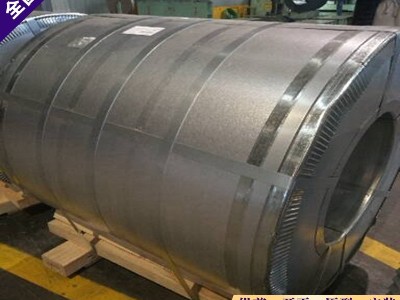浅谈镀锌彩钢板产生滑移线的原因及解决方案
镀锌彩钢板广泛应用于建筑、家电、汽车等行业。镀锌钢板由于其生产工艺复杂,工序繁多,容易产生各种质量缺陷,影响表面美观和用户使用。今天,我想和大家分享这篇文章,谈谈镀锌钢板滑移线缺陷的原因和解决办法。过来看看
1性能特征。
当谎言是可见的和不可见的,在随后的处理中有一个尖锐的触觉纹理。
2原因分析。
在实际生产过程中,
镀锌彩钢板滑移线产生的主要原因有:
(1) 平面度设置不合理。经过一定量的压扁变形后,会产生大量的活动位错。位错消除了固溶体中C原子和N原子的束缚,在较小的应力作用下可以继续变形,从而消除了屈服平台。在一定的平面度下,屈服强度随板形的增加而降低,直至达到最低点,然后屈服平台消失;随着平面度的进一步提高,屈服强度增加,加工硬化增加,变形能力降低,可加工性降低。
(2) 天然处方。
镀锌彩钢板退火压平后,屈服平台消除。在室温条件下,原子在室温下产生弥散位错,并在室温下形成弥散位错。
(3) 人工老化。需要喷涂、烘烤或涂膜加热的镀锌钢板在高温下会重新出现屈服平台。
三。解决。
(1)
镀锌彩钢板合理设置板形不仅可以消除屈服平台,而且可以避免屈服强度的过度增加,降低材料的成形性。
(2) 与连续退火相比,间歇退火工艺的加热和冷却速度较慢(一般为20%/H40~C/h),保温时间较长。退火后,钢中大量的C以FEC形式析出,N原子以A1N的形式充分析出,大大减少了钢中固溶体原子的数量。
(3) 先进的连续退火工艺,如R-OA技术,可以通过快速冷却和低温冷却来提高FEC形核和生长的驱动力,使固溶体C以FEC的形式析出,提高抗老化性能。
(4) 在热轧过程中对板坯进行低温加热,结合高义74新技术、新产品的温卷取工艺,促进了A1N、Fe、C的析出和长大,有效地降低了钢板中固溶体N的含量。
(5) 采用超低碳无间隙原子钢,钢中碳、氮元素含量极低。同时,Ti、Nb等强碳氮化物形成元素能进一步固定C、N原子,彻底解决了老化问题。
Galvanized steel sheet is widely used in construction, home appliances, automobile and other industries. Due to its complex production process and various processes, galvanized steel sheet may produce a variety of quality defects, affecting the surface
beauty and user use. Today, I'd like to share this article to talk about the causes and solutions of slip line defects of galvanized steel sheet. Come and have a look
1. Performance characteristics.
When the lie is visible and not visible, there is a sharp tactile texture in the subsequent processing.
2. Cause analysis.
In the actual production process, the slip line is mainly caused by the following
reasons:
(1) The flatness setting is unreasonable. After a certain amount of flattening deformation, a large number of movable dislocations are produced. The dislocations get rid of the bondage of C and N atoms in solid solution, and the deformation
can continue under a small stress, thus eliminating the yield plateau. Under a certain flatness, the yield strength decreases with the increase of flatness until it reaches the lowest point, and then the yield platform disappears; with the further improvement
of flatness, the yield strength increases, the work hardening increases, the deformation capacity decreases and the machinability decreases.
(2) Natural prescription. After annealing and flattening, the yield plateau of galvanized steel sheet has
been eliminated. After long-term storage at room temperature, C and N atoms re diffuse around the dislocation to form "Coriolis air mass", which results in the re emergence of yield plateau.
(3) Artificial aging. The yield plateau of galvanized
steel sheet which needs to be sprayed, baked or coated with film heating will reappear at high temperature.
3. Solutions.
(1) Reasonable setting of flatness can not only eliminate the yield plateau, but also avoid the excessive increase of
yield strength and reduce the formability of materials.
(2) Compared with continuous annealing, the heating and cooling rates of batch annealing process are slow (generally 20% / H40 ~ C / h), and the holding time is long. After annealing, a large
amount of C in the steel precipitates in the form of FEC, and N atoms fully precipitate in the form of A1N, which greatly reduces the number of solid solution atoms in the steel.
(3) Advanced continuous annealing process, such as R-OA technology,
can improve the driving force of FEC nucleation and growth through rapid cooling and low-temperature cooling, so that the solid solution C can precipitate in the form of FEC, and increase the aging resistance.
(4) The slab is heated at a lower temperature
during hot rolling, and combined with the warm coiling process of new technology and new product of gaoyi74-china, the precipitation and growth of A1N, Fe and C are promoted, and the solid solution N content in the steel plate is effectively reduced.
(5) Using ultra-low carbon interstitial free atomic steel, the steel contains very low amount of C and n elements. At the same time, Ti, Nb and other strong carbonitride forming elements can further fix C and N atoms, which can completely solve the
aging problem.
